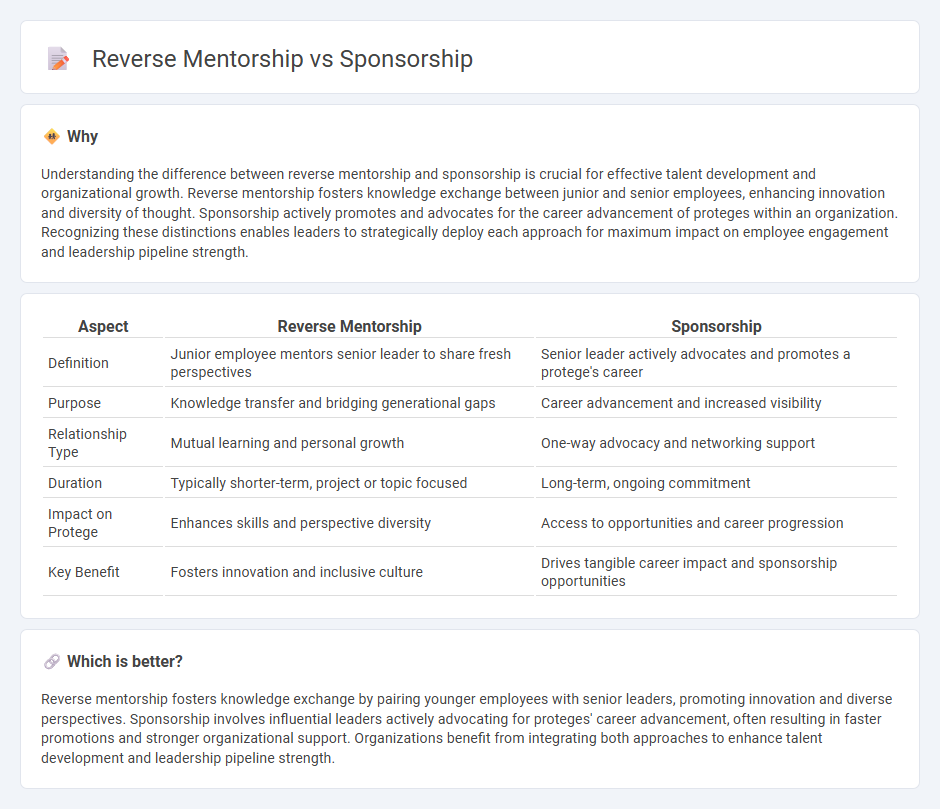
Reverse mentorship empowers junior employees to share insights with senior leaders, fostering innovation and bridging generational gaps. Sponsorship involves senior leaders actively advocating for high-potential employees, accelerating career advancement through visibility and support. Explore how reverse mentorship and sponsorship each uniquely impact organizational growth and leadership development.
Why it is important
Understanding the difference between reverse mentorship and sponsorship is crucial for effective talent development and organizational growth. Reverse mentorship fosters knowledge exchange between junior and senior employees, enhancing innovation and diversity of thought. Sponsorship actively promotes and advocates for the career advancement of proteges within an organization. Recognizing these distinctions enables leaders to strategically deploy each approach for maximum impact on employee engagement and leadership pipeline strength.
Comparison Table
| Aspect | Reverse Mentorship | Sponsorship |
|---|---|---|
| Definition | Junior employee mentors senior leader to share fresh perspectives | Senior leader actively advocates and promotes a protege's career |
| Purpose | Knowledge transfer and bridging generational gaps | Career advancement and increased visibility |
| Relationship Type | Mutual learning and personal growth | One-way advocacy and networking support |
| Duration | Typically shorter-term, project or topic focused | Long-term, ongoing commitment |
| Impact on Protege | Enhances skills and perspective diversity | Access to opportunities and career progression |
| Key Benefit | Fosters innovation and inclusive culture | Drives tangible career impact and sponsorship opportunities |
Which is better?
Reverse mentorship fosters knowledge exchange by pairing younger employees with senior leaders, promoting innovation and diverse perspectives. Sponsorship involves influential leaders actively advocating for proteges' career advancement, often resulting in faster promotions and stronger organizational support. Organizations benefit from integrating both approaches to enhance talent development and leadership pipeline strength.
Connection
Reverse mentorship enhances leadership development by enabling senior managers to gain fresh insights from younger employees, while sponsorship actively promotes these mentees' career advancement within the organization. Both practices foster inclusive talent pipelines and cultural agility, driving innovation and retention. Integrating reverse mentorship with sponsorship creates a dynamic feedback loop that accelerates professional growth and organizational success.
Key Terms
Hierarchical Dynamics
Sponsorship involves a senior leader advocating for a junior employee's career advancement, leveraging their authority and network to create opportunities, while reverse mentorship flips traditional hierarchies by enabling younger or less-experienced employees to guide senior leaders on contemporary issues like technology and diversity. Hierarchical dynamics in sponsorship emphasize top-down influence and power, whereas reverse mentorship fosters a more horizontal, collaborative exchange that challenges conventional power structures. Explore further to understand how these approaches shape leadership development and organizational culture.
Knowledge Transfer
Sponsorship involves experienced leaders advocating for proteges to accelerate their career growth, while reverse mentorship emphasizes knowledge transfer from younger employees to senior leaders, fostering innovation and diverse perspectives. This dynamic exchange enhances organizational learning by bridging generational gaps and promoting continuous development. Explore how integrating both strategies can optimize knowledge transfer within your company.
Power Balance
Sponsorship involves a senior leader actively advocating for a protege's career advancement, leveraging their influence and power within an organization, whereas reverse mentorship redistributes power by enabling junior employees to share insights and expertise with senior leaders, fostering mutual learning. The power balance in sponsorship is top-down, driven by authority and network access, while reverse mentorship promotes a bottom-up dynamic where less experienced individuals gain influence through knowledge sharing. Explore how these approaches reshape workplace hierarchies and career development by discovering more about their unique impacts.
Source and External Links
How to Get Sponsorships for Your Business - A sponsorship is when a corporation provides money or resources to a business or non-profit in exchange for promotion, creating a mutual benefit where the sponsor gains exposure and the business gains funds or resources.
What is sponsorship? | SPORTFIVE - sportsmarketing agency - Sponsorship is a business relationship where a company supports an event, person, or organization financially or materially in exchange for advertising and positive publicity, with common types including sports, cultural, educational, and social sponsorships.
How to Unlock Corporate Sponsorships: Get More Support - Corporate sponsorships help nonprofits fund projects or events by providing financial, in-kind, or media support, while companies benefit through tax deductions and positive brand association.
 dowidth.com
dowidth.com